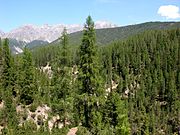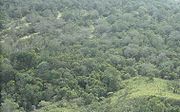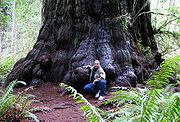
Forest
Did you know...
SOS Children, an education charity, organised this selection. Sponsoring children helps children in the developing world to learn too.
A forest is an area with a high density of trees. There are many definitions of a forest, based on various criteria. These plant communities cover approximately 9.4% of the Earth's surface (or 30% of total land area) and function as habitats for organisms, hydrologic flow modulators, and soil conservers, constituting one of the most important aspects of the Earth's biosphere. Historically, "forest" meant an uncultivated area legally set aside for hunting by feudal nobility, and these hunting forests were not necessarily wooded much if at all (see Royal Forest). However, as hunting forests did often include considerable areas of woodland, the word forest eventually came to mean wooded land more generally. A woodland is ecologically distinct from a forest.
Distribution
Forests can be found in all regions capable of sustaining tree growth, at altitudes up to the tree line, except where natural fire frequency is too high, or where the environment has been impaired by natural processes or by human activities. As a general rule, forests dominated by angiosperms (broadleaf forests) are more species-rich than those dominated by gymnosperms (conifer, montane, or needleleaf forests), although exceptions exist. Forests sometimes contain many tree species within a small area (as in tropical rain and temperate deciduous forests), or relatively few species over large areas (e.g., taiga and arid montane coniferous forests). Forests are often home to many animal and plant species, and biomass per unit area is high compared to other vegetation communities. Much of this biomass occurs below ground in the root systems and as partially decomposed plant detritus. The woody component of a forest contains lignin, which is relatively slow to decompose compared with other organic materials such as cellulose or carbohydrate.
Forests are differentiated from woodlands by the extent of canopy coverage: in a forest the branches and the foliage of separate trees often meet or interlock, although there can be gaps of varying sizes within an area referred to as forest. A woodland has a more continuously open canopy, with trees spaced further apart, which allows more sunlight to penetrate to the ground between them (see also savanna).
Among the major forested biomes are:
- rain forest (tropical and temperate)
- taiga
- temperate hardwood forest
- tropical dry forest
Classification
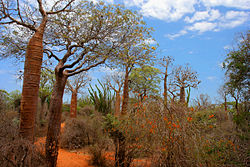
Forests can be classified in different ways and to different degrees of specificity. One such way is in terms of the "biome" in which they exist, combined with leaf longevity of the dominant species (whether they are evergreen or deciduous). Another distinction is whether the forests composed predominantly of broadleaf trees, coniferous (needle-leaved) trees, or mixed.
- Boreal forests occupy the subarctic zone and are generally evergreen and coniferous.
- Temperate zones support both broadleaf deciduous forests (e.g., temperate deciduous forest) and evergreen coniferous forests (e.g., Temperate coniferous forests and Temperate rainforests). Warm temperate zones support broadleaf evergreen forests, including laurel forests.
- Tropical and subtropical forests include tropical and subtropical moist forests, tropical and subtropical dry forests, and tropical and subtropical coniferous forests.
- Physiognomy classifies forests based on their overall physical structure or developmental stage (e.g. old growth vs. second growth).
- Forests can also be classified more specifically based on the climate and the dominant tree species present, resulting in numerous different forest types (e.g., ponderosa pine/Douglas-fir forest).
A number of global forest classification systems have been proposed but none has gained universal acceptance.UNEP-WCMC's forest category classification system is a simplification of other more complex systems (e.g. UNESCO's forest and woodland 'subformations'). This system divides the world's forest into 26 major types, which reflect climatic zones as well as the principal types of trees. These 26 major types can be reclassified into 6 broader categories:
- Temperate needleleaf
Temperate needleleaf forests mostly occupy the higher latitude regions of the northern hemisphere, as well as high altitude zones and some warm temperate areas, especially on nutrient-poor or otherwise unfavourable soils. These forests are composed entirely, or nearly so, of coniferous species ( Coniferophyta). In the Northern Hemisphere pines Pinus, spruces Picea, larches Larix, silver firs Abies, Douglas firs Pseudotsuga and hemlocks Tsuga, make up the canopy, but other taxa are also important. In the southern hemisphere most coniferous trees, members of the Araucariaceae and Podocarpaceae, occur in mixtures with broadleaf species that are classed as broadleaf and mixed forests.
- Temperate broadleaf and mixed
Temperate broadleaf and mixed forests include a substantial component of trees in the Anthophyta. They are generally characteristic of the warmer temperate latitudes, but extend to cool temperate ones, particularly in the southern hemisphere. They include such forest types as the mixed deciduous forests of the USA and their counterparts in China and Japan, the broadleaf evergreen rain forests of Japan, Chile and Tasmania, the sclerophyllous forests of Australia, the Mediterranean and California, and the southern beech Nothofagus forests of Chile and New Zealand.
- Tropical moist
Tropical moist forests include many different forest types. The best known and most extensive are the lowland evergreen broadleaf rainforests include, for example: the seasonally inundated varzea and igapó forests and the terra firme forests of the Amazon Basin; the peat forests and moist dipterocarp forests of Southeast Asia; and the high forests of the Congo Basin. The forests of tropical mountains are also included in this broad category, generally divided into upper and lower montane formations on the basis of their physiognomy, which varies with altitude. The montane forests include cloud forest, those forests at middle to high altitude, which derive a significant part of their water budget from cloud, and support a rich abundance of vascular and nonvascular epiphytes. Mangrove forests also fall within this broad category, as do most of the tropical coniferous forests of Central America.
- Tropical dry
Tropical dry forests are characteristic of areas in the tropics affected by seasonal drought. The seasonality of rainfall is usually reflected in the deciduousness of the forest canopy, with most trees being leafless for several months of the year. However, under some conditions, e.g. less fertile soils or less predictable drought regimes, the proportion of evergreen species increases and the forests are characterised as " sclerophyllous". Thorn forest, a dense forest of low stature with a high frequency of thorny or spiny species, is found where drought is prolonged, and especially where grazing animals are plentiful. On very poor soils, and especially where fire is a recurrent phenomenon, woody savannas develop (see 'sparse trees and parkland').
- Sparse trees and parkland
Sparse trees and parkland are forests with open canopies of 10-30% crown cover. They occur principally in areas of transition from forested to non-forested landscapes. The two major zones in which these ecosystems occur are in the boreal region and in the seasonally dry tropics. At high latitudes, north of the main zone of boreal forest or taiga, growing conditions are not adequate to maintain a continuous closed forest cover, so tree cover is both sparse and discontinuous. This vegetation is variously called open taiga, open lichen woodland, and forest tundra. It is species-poor, has high bryophyte cover, and is frequently affected by fire.
- Forest plantations
Forest plantations, generally intended for the production of timber and pulpwood increase the total area of forest worldwide. Commonly mono-specific and/or composed of introduced tree species, these ecosystems are not generally important as habitat for native biodiversity. However, they can be managed in ways that enhance their biodiversity protection functions and they are important providers of ecosystem services such as maintaining nutrient capital, protecting watersheds and soil structure as well as storing carbon. They may also play an important role in alleviating pressure on natural forests for timber and fuelwood production.
26 forest categories are used to enable the translation of forest types from national and regional classification systems to a harmonised global one:
Temperate and boreal forest types
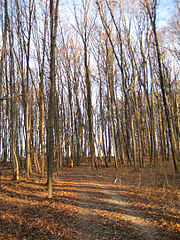
(1) Evergreen needleleaf forest - Natural forest with > 30% canopy cover, in which the canopy is predominantly (> 75%) needleleaf and evergreen.
(2) Deciduous needleleaf forest - Natural forests with > 30% canopy cover, in which the canopy is predominantly (> 75%) needleleaf and deciduous.
(3) Mixed broadleaf/needleleaf forest - Natural forest with > 30% canopy cover, in which the canopy is composed of a more or less even mixture of needleleaf and broadleaf crowns (between 50:50% and 25:75%).
(4) Broadleaf evergreen forest - Natural forests with > 30% canopy cover, the canopy being > 75% evergreen and broadleaf.
(5) Deciduous broadleaf forest - Natural forests with > 30% canopy cover, in which > 75% of the canopy is deciduous and broadleaves predominate (> 75% of canopy cover).
(6) Freshwater swamp forest - Natural forests with > 30% canopy cover, composed of trees with any mixture of leaf type and seasonality, but in which the predominant environmental characteristic is a waterlogged soil.
(7) Sclerophyllous dry forest - Natural forest with > 30% canopy cover, in which the canopy is mainly composed of sclerophyllous broadleaves and is > 75% evergreen.
(8) Disturbed natural forest - Any forest type above that has in its interior significant areas of disturbance by people, including clearing, felling for wood extraction, anthropogenic fires, road construction, etc.
(9) Sparse trees and parkland - Natural forests in which the tree canopy cover is between 10-30%, such as in the steppe regions of the world. Trees of any type (e.g., needleleaf, broadleaf, palms).
(10) Exotic species plantation - Intensively managed forests with > 30% canopy cover, which have been planted by people with species not naturally occurring in that country.
(11) Native species plantation - Intensively managed forests with > 30% canopy cover, which have been planted by people with species that occur naturally in that country.
(12)* Unspecified forest plantation - Forest plantations showing extent only with no further information about their type, This data currently only refers to the Ukraine.
(13)* Unclassified forest data - Forest data showing forest extent only with no further information about their type.
Tropical forest types
(14) Lowland evergreen broadleaf rain forest - Natural forests with > 30% canopy cover, below 1200 m altitude that display little or no seasonality, the canopy being >75% evergreen broadleaf.
(15) Lower montane forest - Natural forests with > 30% canopy cover, between 1200-1800 m altitude, with any seasonality regime and leaf type mixture.
(16) Upper montane forest - Natural forests with > 30% canopy cover, above 1800 m altitude, with any seasonality regime and leaf type mixture.
(17) Freshwater swamp forest - Natural forests with > 30% canopy cover, below 1200 m altitude, composed of trees with any mixture of leaf type and seasonality, but in which the predominant environmental characteristic is a waterlogged soil.
(18) Semi-evergreen moist broadleaf forest - Natural forests with > 30% canopy cover, below 1200 m altitude in which between 50-75% of the canopy is evergreen, > 75% are broadleaves, and the trees display seasonality of flowering and fruiting.
(19) Mixed broadleaf/needleleaf forest - Natural forests with > 30% canopy cover, below 1200 m altitude, in which the canopy is composed of a more or less even mixture of needleleaf and broadleaf crowns (between 50:50% and 25:75%).
(20) Needleleaf forest - Natural forest with > 30% canopy cover, below 1200 m altitude, in which the canopy is predominantly (> 75%) needleleaf.
(21) Mangroves - Natural forests with > 30% canopy cover, composed of species of mangrove tree, generally along coasts in or near brackish or salt water.
(22) Disturbed natural forest - Any forest type above that has in its interior significant areas of disturbance by people, including clearing, felling for wood extraction, anthropogenic fires, road construction, etc.
(23) Deciduous/semi-deciduous broadleaf forest - Natural forests with > 30% canopy cover, below 1200 m altitude in which between 50-100% of the canopy is deciduous and broadleaves predominate (> 75% of canopy cover).
(24) Sclerophyllous dry forest - Natural forests with > 30% canopy cover, below 1200 m altitude, in which the canopy is mainly composed of sclerophyllous broadleaves and is > 75% evergreen.
(25) Thorn forest - Natural forests with > 30% canopy cover, below 1200 m altitude, in which the canopy is mainly composed of deciduous trees with thorns and succulent phanerophytes with thorns may be frequent.
(26) Sparse trees and parkland - Natural forests in which the tree canopy cover is between 10-30%, such as in the savannah regions of the world. Trees of any type (e.g., needleleaf, broadleaf, palms).
(27) Exotic species plantation - Intensively managed forests with > 30% canopy cover, which have been planted by people with species not naturally occurring in that country.
(28) Native species plantation - Intensively managed forests with > 30% canopy cover, which have been planted by people with species that occur naturally in that country.
12* and 13* have been created as a result of data holdings which do not specify the forest type, hence 26 categories are quoted, not 28 shown here.
Forest management and forest loss
The scientific study of forest species and their interaction with the environment is referred to as forest ecology, while the management of forests is often referred to as forestry. Forest management has changed considerably over the last few centuries, with rapid changes from the 1980s onwards culminating in a practice now referred to as sustainable forest management. Forest ecologists concentrate on forest patterns and processes, usually with the aim of elucidating cause and effect relationships. Foresters who practice sustainable forest management focus on the integration of ecological, social and economic values, often in consultation with local communities and other stakeholders.
Anthropogenic factors that can affect forests include logging, human-caused forest fires, acid rain, and introduced species, among other things. There are also many natural factors that can cause changes in forests over time including forest fires, insects, diseases, weather, competition between species, etc. In 1997, the World Resources Institute recorded that only 20% of the world's original forests remained in large intact tracts of undisturbed forest . More than 75% of these intact forests lie in three countries - the Boreal forests of Russia and Canada and the rainforest of Brazil. In 2006 this information on intact forests was updated using latest available satellite imagery.
Canada has about 4,020,000 km² of forest land. More than 90% of forest land is publicly owned and about 50% of the total forest area is allocated for harvesting. These allocated areas are managed using the principles of sustainable forest management, which includes extensive consultation with local stakeholders. About eight percent of Canada’s forest is legally protected from resource development (Global Forest Watch Canada) (Natural Resources Canada). Much more forest land — about 40 percent of the total forest land base — is subject to varying degrees of protection through processes such as integrated land-use planning or defined management areas such as certified forests (Natural Resources Canada). By December 2006, over 1,237,000 square kilometers of forest land in Canada (about half the global total) had been certified as being sustainably managed (Canadian Sustainable Forestry Certification Coalition). Clearcutting is usually the harvest method of choice and companies are required by law to ensure that harvested areas are adequately regenerated. Most Canadian provinces have regulations limiting the size of clearcuts, although some older clearcuts can range upwards of 110 km² (20,000 acres) in size which were cut over several years.
In the United States, most forests have historically been affected by humans to some degree, though in recent years improved forestry practices has helped regulate or moderate large scale or severe impacts. However the United States Forest Service estimates that every year about 6,000 km² (1.5 million acres) of the nation’s 3,000,000 km² (750 million acres) of forest land is lost to urban sprawl and development. It is expected that the South alone will lose 80,000 to 100,000 km² (20 to 25 million acres) to development. However, in many areas of the United States, the area of forest is stable or increasing, particularly in many northern states.
Globally two broad types of forests can be identified: natural and anthropogenic.
Natural forests contain mainly natural patterns of biodiversity in established seral patterns, and they contain mainly species native to the region and habitat. The natural formations and processes have not been affected by humans with a frequency or intensity to change the natural structure and components of the habitat.
Anthropogenic forests have been created by humans or sufficiently affected by humans to change or remove natural seral patterns. They often contain significant elements of species which were originally from other regions or habitats.

